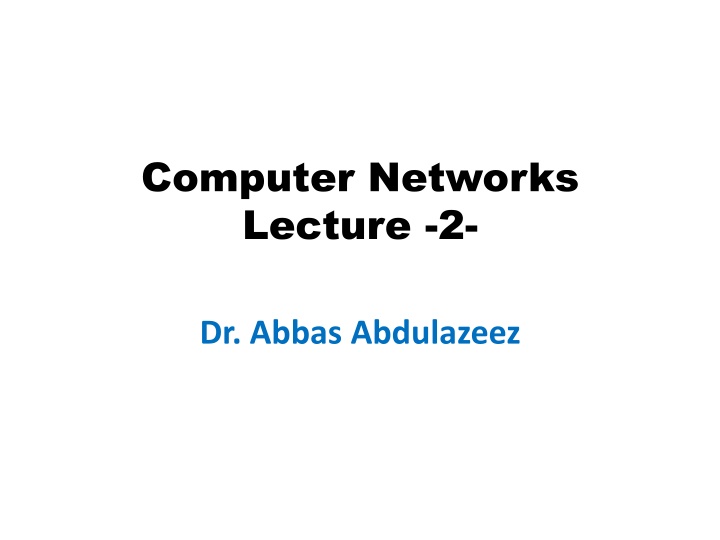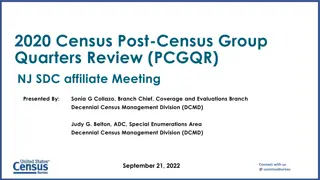
Understanding Network Classifications and Topologies
Explore the categories of networks, classifications based on connection types, and topologies in computer networking. Learn about point-to-point, multipoint networks, and different network layouts like mesh, bus, star, and ring topologies.
Download Presentation

Please find below an Image/Link to download the presentation.
The content on the website is provided AS IS for your information and personal use only. It may not be sold, licensed, or shared on other websites without obtaining consent from the author. If you encounter any issues during the download, it is possible that the publisher has removed the file from their server.
You are allowed to download the files provided on this website for personal or commercial use, subject to the condition that they are used lawfully. All files are the property of their respective owners.
The content on the website is provided AS IS for your information and personal use only. It may not be sold, licensed, or shared on other websites without obtaining consent from the author.
E N D
Presentation Transcript
Computer Networks Lecture -2- Dr. Abbas Abdulazeez
Categories of Networks Categories of Networks Topology Distance Connection Type PAN LAN MAN WAN Point-to-point Multipoint. Mesh Bus Star Ring.
Classifications Based on Type of Connection A link is a communications channel that transfers data from one device to another. 1. Point-to-Point: A point-to-point connection provides a dedicated link between two devices. The entire capacity of the link is reserved for transmission between those two devices
Classifications Based on Type of Connection The short messages called packets in certain contexts, may have to first visit one or more intermediate machines. Often multiple routes, of different lengths, are possible, so finding good ones is important in point-to-point networks. When you change television channels by infrared remote control, you are establishing a point-to-point connection between the remote control and the television's control system. Point-to-point transmission with exactly one sender and exactly one receiver is sometimes called unicasting.
Classifications Based on Type of Connection 2- Multipoint network (also called broadcast): the communication channel machines on the network; packets sent by any machine are received by all the others. is shared by all the An address field within each packet specifies the intended recipient. Upon receiving a packet, a machine checks the address field. If the packet is intended for the receiving machine, that machine processes the packet; if the packet is intended for some other machine, it is just ignored.
Classifications Based on Topology The term topology refers to the way in which a network is laid out physically. Two or more devices connect to a link; two or more links form a topology. The topology of a network is the geometric representation of the relationship of all the links and linking devices (usually called nodes) to one another. There are four basic topologies possible: mesh, bus, star, and ring.
Classifications Based on Topology (Mesh) In a mesh topology, every device has a dedicated point-to-point link to every other device. The term dedicated means that the link carries traffic only between the two devices it connects.
Classifications Based on Topology (Mesh) In a fully connected mesh network, we need n(n - 1) physical links (Simple mode). However, if each physical link allows communication in both directions (duplex mode), we can divide the number of links by 2. In other words, we can say that in a mesh topology, we need n(n - 1)/2.
Classifications Based on Topology (Mesh) A mesh offers several advantages over other network topologies. First, the use of dedicated links guarantees that each connection can carry its own data load, thus eliminating the traffic problems that can occur when links must be shared by multiple devices. Second, a mesh topology is robust. If one link becomes unusable, it does not incapacitate the entire system. Third, there is the advantage of privacy or security. When every message travels along a dedicated line, only the intended recipient sees it. Physical boundaries prevent other users from gaining access to messages. Finally, point-to-point links make fault identification and fault isolation easy.
Classifications Based on Topology (Mesh) The main disadvantages of a mesh are related to the amount of cabling and the number of I/O ports required. First, because every device must be connected to every other device, installation and reconnection are difficult. Second, the sheer bulk of the wiring can be greater than the available space (in walls, ceilings, or floors) can accommodate. Finally, the hardware required to connect each link (I/O ports and cable) can be prohibitively expensive. For these reasons a mesh topology is usually implemented in a limited fashion.
Classifications Based on Topology (Bus) Nodes are connected to the bus cable by drop lines and taps. A drop line is a connection running between the device and the main cable. A tap is a connector. Bus is multipoint As a signal travels along the backbone, some of its energy is transformed into heat. Therefore, it becomes weaker and weaker as it travels farther and farther. For this reason there is a limit on the number of taps a bus can support and on the distance between those taps.
Classifications Based on Topology (Bus) Advantages of a bus topology include ease of installation. A bus uses less cabling than mesh or star topologies. Disadvantages include difficult reconnection and fault isolation. A bus is usually designed to be optimally efficient at installation. It can therefore be difficult to add new devices. Signal reflection at the taps can cause degradation in quality. This degradation can be controlled by limiting the number and spacing of devices connected to a given length of cable. Adding new devices may therefore require modification or replacement of the backbone.
Classifications Based on Topology (Star) In a star topology, each device has a dedicated point-to-point link only to a central controller, usually called a hub.
Classifications Based on Topology (Star) The devices are not directly linked to one another. Unlike a mesh topology, a star topology does not allow direct traffic between devices. The controller acts as an exchange: If one device wants to send data to another, it sends the data to the controller, which then relays the data to the other connected device.
Classifications Based on Topology (Star) Advantages: A star topology is less expensive than a mesh topology. In a star, each device needs only one link and one I/O port to connect it to any number of others. This factor also makes it easy to install and reconfigure. Far less cabling needs to be additions and deletions involve only one connection: between that device and the hub. Other advantages include robustness. If one link fails, only that link is affected. All other links remain active. This factor also lends itself to easy fault identification and fault isolation. As long as the hub is working, it can be used to monitor link problems and by pass defective links.
Classifications Based on Topology (Star) One big disadvantage of a star topology is the dependency of the whole topology on one single point, the hub. If the hub goes down, the whole system is dead. Although a star requires far less cable than a mesh, each node must be linked to a central hub. For this reason, often more cabling is required in a star than in some other topologies (such as ring or bus).
Classifications Based on Topology (Ring) In a ring topology, each device has a dedicated point-to-point connection with only the two devices on either side of it. A signal is passed along the ring in one direction, from device to device, until destination. Each device in the ring incorporates a repeater. When a device receives a signal intended for another device, its repeater regenerates the bits and passes them along. it reaches its
Classifications Based on Topology (Ring) Disadvantages: A ring is relatively easy to install and reconfigure. Each device is linked to only its immediate neighbors (either physically or logically). To add or delete a device requires changing only two connections. In addition, fault isolation is simplified. Generally in a ring, a signal is circulating at all times. If one device does not receive a signal within a specified period, it can issue an alarm. The alarm alerts the network operator to the problem and its location.
Classifications Based on Topology (Ring) However, disadvantage. In a simple ring, a break in the ring (such as a disabled station) can disable the entire network. This weakness can be solved by using a dual ring or a switch capable of closing off the break. unidirectional traffic can be a
Classifications Based on Topology (Hybrid) A network can be hybrid. For example, we can have a main star topology with each branch connecting several stations in a bus topology.
Classifications Based on Distance Distance is important as a classification metric because different technologies are used at different scales. The Table (1.1) display the classification of multiple processor systems by their rough physical size.
Classifications Based on Distance (PANs) PANs (Personal Area Networks) let devices communicate over the range of a person. A common example is a (wire or wireless) network that connects a computer with its peripherals. Almost every computer has an attached monitor, keyboard, mouse, and printer. One example, short-range wireless network called Bluetooth.
Classifications Based on Distance (LAN) A local area network (LAN) is usually privately owned and links the devices in a single office, building, or campus.
Classifications Based on Distance (WAN) A wide area network (WAN) provides long-distance transmission of data, image, audio, and video information over large geographic areas that may comprise a country, a continent, or even the whole world.
Classifications Based on Distance (MAN) A metropolitan area network (MAN) is a network with a size between a LAN and a WAN. It normally covers the area inside a town or a city. Example is the telephone company network and cable TV network.











